| Karkee Web Home Page | Pattern 1958 Home Page | Patt. '58 Components Page |
Web Equipment, Pattern 1958 - Components
Non Pattern 1958 - Local Pattern and User Mods
Stores Ref. None “BELT, ROLL-PIN, user made”
 When stores are parachuted, they are secured to pallets, etc with heavy-duty Straps, Securing, Airborne freight. These were made of 2-inch webbing and came in four lengths, 5-ft 6-ins (A4/AD 0542), 8-ft. (A4/AD 0543), 12-ft. (A4/AD 0544) and 15-t. (A4/AD 0545). Later, a 2-ft. strap (A4/AD 0546) was added. They were made up in sets, coded A4/AD 0541, which comprised (in 1954) four off 8-ft, 19 off 12- ft and four off 15-ft.
When stores are parachuted, they are secured to pallets, etc with heavy-duty Straps, Securing, Airborne freight. These were made of 2-inch webbing and came in four lengths, 5-ft 6-ins (A4/AD 0542), 8-ft. (A4/AD 0543), 12-ft. (A4/AD 0544) and 15-t. (A4/AD 0545). Later, a 2-ft. strap (A4/AD 0546) was added. They were made up in sets, coded A4/AD 0541, which comprised (in 1954) four off 8-ft, 19 off 12- ft and four off 15-ft.
These were much coveted by soldiers generally, as a far more serviceable Belt could be created usng this “raw” material. Under vertical loads, the “C” hooks and loops could compress and therefore distort the upper beaded edge of a Patt. ’58 Waist belt. A better solution was to stitch together a lamination of two layers of load strapping, over the greater part of its circumference as a “belt”.
An additional advantage was the Mills’ Patent buckle that formed part of the original load strap. The term “roll-pin” strictly applies to U.S. trouser belt buckle design, but it was in colloquial use to describe the Mills design, which was more a “sliding pin” buckle, designed to tension a strapped load, but also to be capable of quick release. It took the form of a closed rectangular frame, in round-section bar stock. Around one long edge, a folded plate was riveted tightly. This was slotted for a short webbing pull tab to be stitched on. The centre bar of the buckle was almost twice the diameter of the frame, deeply grooved at each end, which left it free to slide along both short sides of the frame. The centre bar was also heavily machine knurled. The running end of the strap was brought from behind the frame, doubled over the knurled bar and then passed under the frame with its plate. Pulled tight, friction kept in place and tension pulled the centre bar up tight to the frame and plate. From the Simon Howlett Collection. Photo © Simon Howlett 2012.
Stores Ref. None “POUCHES, REAR, SUBSTITUTE”

 The nomenclature is not official and is ascribed to a “user-mod”, whereby up to six Water canteen carriers were often stitched together along their front vertical seams only, thus forming a multi-cell and compact substitute for the Pouches, rear. This form of user-mod, with varying numbers of Carriers, was not un-common. The six examples here are the largest number seen, occupying almost all of the Belt length, between the Ammunition pouches. From the Rog Dennis Collection. Photos © Rog Dennis 2012.
The nomenclature is not official and is ascribed to a “user-mod”, whereby up to six Water canteen carriers were often stitched together along their front vertical seams only, thus forming a multi-cell and compact substitute for the Pouches, rear. This form of user-mod, with varying numbers of Carriers, was not un-common. The six examples here are the largest number seen, occupying almost all of the Belt length, between the Ammunition pouches. From the Rog Dennis Collection. Photos © Rog Dennis 2012.
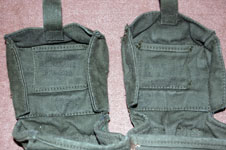
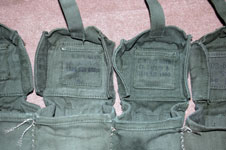
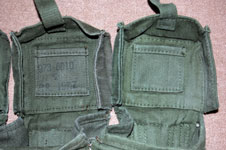 The lid markings, mostly un-readable, respectively for the LH, centre and RH pairs.
The lid markings, mostly un-readable, respectively for the LH, centre and RH pairs.
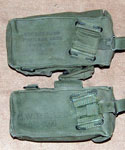 These 3rd Issue Pouches formed part of the Liddicoat set, using the Belt, long at Fig. 1B above. Note the size variation in markings, with M.W.&.S large size, but also the idiot-proofing of POUCH, AMM, RIGHT marked on the upper pouch – a style that crept in – aping the U.S. practice.
These 3rd Issue Pouches formed part of the Liddicoat set, using the Belt, long at Fig. 1B above. Note the size variation in markings, with M.W.&.S large size, but also the idiot-proofing of POUCH, AMM, RIGHT marked on the upper pouch – a style that crept in – aping the U.S. practice.
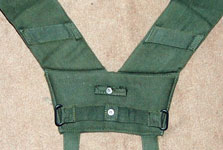 The Belt was supported by the 2nd Issue Yoke illustrated, which has had the broad strap with its spigot cut off, so as not to interfere with a Rucksack, rather than the Patt. ’58 Pack. Not shown is the nylon Haversack, respirator, A.G. for an S6 Respirator. This had a long fairlead, which had been very concertina’d, in order to jam it between the RH Pouch ammunition and the right-hand “pocket” of the substitute Rear pouches set. The “C” hooks of each Canteen carrier occupied so many of the pockets in the flat-loop belting, that it was exceedingly difficult to pinch the Belt to get them off! Two Carriers even had their hooks in the same pocket as the rear Yoke attachments, making their removal even more difficult. From the Rog Dennis Collection. Photos © Rog Dennis 2012.
The Belt was supported by the 2nd Issue Yoke illustrated, which has had the broad strap with its spigot cut off, so as not to interfere with a Rucksack, rather than the Patt. ’58 Pack. Not shown is the nylon Haversack, respirator, A.G. for an S6 Respirator. This had a long fairlead, which had been very concertina’d, in order to jam it between the RH Pouch ammunition and the right-hand “pocket” of the substitute Rear pouches set. The “C” hooks of each Canteen carrier occupied so many of the pockets in the flat-loop belting, that it was exceedingly difficult to pinch the Belt to get them off! Two Carriers even had their hooks in the same pocket as the rear Yoke attachments, making their removal even more difficult. From the Rog Dennis Collection. Photos © Rog Dennis 2012.
Stores Ref. None “CARRIER, CANTEEN, WATER, w. Q.R. fastener”
 The Issue 2 Carrier has been noted with the strap and buckle removed and the QR fastener from a Patt. ’58 Ammunition pouch substituted. From the Simon Howlett Collection. Photo © Simon Howlett 2012.
The Issue 2 Carrier has been noted with the strap and buckle removed and the QR fastener from a Patt. ’58 Ammunition pouch substituted. From the Simon Howlett Collection. Photo © Simon Howlett 2012.
Stores Ref. None POCKET, MAGAZINE, ARMALITE (LOCAL PATTERN)



 Three examples have been encountered, which at least gives it the status of Local Pattern, the source being Hong Kong. The nomenclature is derived from a description given by a collector, who acquired it in Hong Kong, where his father was serving. Beautifully made, but in a lighter green webbing, being made from bits of Patt. 44 material, but with Patt ’58 fittings. A gusset gives it a rectangular section and two “C” clips are fitted to the rear. The box-lid flap is stylishly shaped, in the manner of 1st Issue Ammunition Pouches. An M-1 Carbine magazine is a loose fit, as is an HP magazine. Two HP magazines, edge-on to the wearer’s body, do fit, but the gusset is not sized for this.
Three examples have been encountered, which at least gives it the status of Local Pattern, the source being Hong Kong. The nomenclature is derived from a description given by a collector, who acquired it in Hong Kong, where his father was serving. Beautifully made, but in a lighter green webbing, being made from bits of Patt. 44 material, but with Patt ’58 fittings. A gusset gives it a rectangular section and two “C” clips are fitted to the rear. The box-lid flap is stylishly shaped, in the manner of 1st Issue Ammunition Pouches. An M-1 Carbine magazine is a loose fit, as is an HP magazine. Two HP magazines, edge-on to the wearer’s body, do fit, but the gusset is not sized for this.
As there are no markings, it cannot be dated, so may have preceded the special-to-type Armalite pouch for four magazines, which was intended only for the S.A.S. anyway. Perhaps several pockets were worn, for a Guard Order, perhaps on border patrol in the New Territories? Any further details would be welcomed. From the Simon Howlett Collection. Photo © Simon Howlett 2012.
Stores Ref. None POUCH, AMMUNITION, Modified for bungees
 This was done, regardless of Issue and on other than just the Ammunition pouches. The example here is a 2nd Issue right-hand Ammunition pouch. The back has two slits cut into it, in order that a bungee can be hooked on, the bungee being passed through similar slits in the Water bottle carrier, “kidney” Pouches, etc. Soldiers often used these hooked elastic cords to bind the Belt pouches more tightly around the hips. This was expedient, but was un-official and later P.L.C.E. patterns had low-set loops on the reverse faces for this purpose. A case of a user-mod receiving official attention. From the Rog Dennis Collection. Photos © Rog Dennis 2012.
This was done, regardless of Issue and on other than just the Ammunition pouches. The example here is a 2nd Issue right-hand Ammunition pouch. The back has two slits cut into it, in order that a bungee can be hooked on, the bungee being passed through similar slits in the Water bottle carrier, “kidney” Pouches, etc. Soldiers often used these hooked elastic cords to bind the Belt pouches more tightly around the hips. This was expedient, but was un-official and later P.L.C.E. patterns had low-set loops on the reverse faces for this purpose. A case of a user-mod receiving official attention. From the Rog Dennis Collection. Photos © Rog Dennis 2012.
Stores Ref. None POUCH, REAR, MODIFIED
 In a few instances, the linked Pouches, rear were separated by the S.A.S. With the two keyway secured belt loops, nothing was lost, but a large “utility” Pouch could be added to a Belt Order, by those who preferred this. Two forms have been noted, the first being the un-modified and now single Pouch, but the second had the central QR closure strap removed and stitched to one side. A matching QR strap was then added to the opposite side, giving a more weatherproof double closure to the box-lid. Obvious really and the Army should have done this officially! Below, reference is made to an R.A.F. Regiment Sergeant, who also sketched the Rear pouches separated, with the Compass case carried between the two Pouches. It is not known if this was a user-preference – more probably, or was standard practice within the R.A.F. Regiment. From the Simon Howlett Collection. Photo © Simon Howlett 2012.
In a few instances, the linked Pouches, rear were separated by the S.A.S. With the two keyway secured belt loops, nothing was lost, but a large “utility” Pouch could be added to a Belt Order, by those who preferred this. Two forms have been noted, the first being the un-modified and now single Pouch, but the second had the central QR closure strap removed and stitched to one side. A matching QR strap was then added to the opposite side, giving a more weatherproof double closure to the box-lid. Obvious really and the Army should have done this officially! Below, reference is made to an R.A.F. Regiment Sergeant, who also sketched the Rear pouches separated, with the Compass case carried between the two Pouches. It is not known if this was a user-preference – more probably, or was standard practice within the R.A.F. Regiment. From the Simon Howlett Collection. Photo © Simon Howlett 2012.
Stores Ref. CN / X / 11871 LPG 4338 POUCH, MAGAZINES, SLR (Local Pattern)
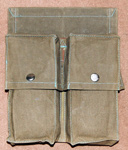
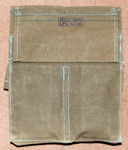
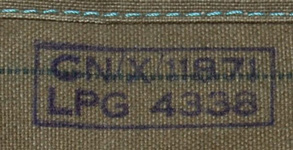 The nomenclature is unknown, so the above has been ascribed. Normally, L.Ps., by their nature, do not appear in V.A.O.S., C.O.S.A., etc. However, bucking the trend, this item does have what appear to be Stores Codes, in a cartouche on the reverse. There is neither a maker, nor a date of manufacture. The CN prefix obviously places this in the COSA Section covering Accoutrements and Steel Helmets. The “X” probably indicates “Experimental”, but the five digit number is not an NSN, but could be a Pattern Number. For probably every item KW has covered, there is a Pattern Number and this has nothing to do with Pattern Years. In addition, there is a Specification Number, but we have made no attempt to dip into these! Below this code is LPG 4338, for which it is tempting to translate LP as “Local Pattern” – but then there’s the “G” (Germany?) and another number! We have no idea!!
The nomenclature is unknown, so the above has been ascribed. Normally, L.Ps., by their nature, do not appear in V.A.O.S., C.O.S.A., etc. However, bucking the trend, this item does have what appear to be Stores Codes, in a cartouche on the reverse. There is neither a maker, nor a date of manufacture. The CN prefix obviously places this in the COSA Section covering Accoutrements and Steel Helmets. The “X” probably indicates “Experimental”, but the five digit number is not an NSN, but could be a Pattern Number. For probably every item KW has covered, there is a Pattern Number and this has nothing to do with Pattern Years. In addition, there is a Specification Number, but we have made no attempt to dip into these! Below this code is LPG 4338, for which it is tempting to translate LP as “Local Pattern” – but then there’s the “G” (Germany?) and another number! We have no idea!!
The material is extremely fine woven, lightweight mid-green canvas and the construction is quite complex. It comprises just four pieces of canvas - backing piece, belt loop, pocket section and lid section, which are all stitched together with single lines of stitching and quite ingeniously. Viewed from the back, the top two-thirds of vertical edges are folded outwards, the remainder inwards. A broad fairlead is placed across this change in hem direction, stitched into place and folded upwards. Its cut edge is stitched under the top edge, which is also folded outwards. Each pocket is of rectangular cross section, the forward edges of which have a sewn-in crease (an old Army dodge with B.D. trousers!!) The rear vertical edges on bottom edge are turned under and stitched into place onto the backing piece on their outer seams, but only for ¾-inch above the centre cut-out. The lids therefore cover the contents quite comprehensively, but it must have been quite difficult to extract a magazine? Lid closure is with Trade Pattern press fasteners.
The bottoms are in one-piece with the pockets, the front to back seams being folded inwards and stitched, creating the impression of a separate piece. A double line of single stitching divides the material into two pockets, the top edges of which have the cut edges turned inwards & stitched. The box-lids are mirror-images of the pocket bodies, all in one piece of material, with just the centre section cut out to separate the flaps. All cut edges are turned under & stitched. The lids are full-depth on all sides and close over the pocket bodies with a 11/2-inch overlap. The upper rear lid seam has its cut edge turned under, where it is stitched to the backing piece, leaving 11/2-inches of the belt fairlead above the lids, thus forming a “dropped” belt loop.
Thus far, the period of trial / theatre use is unknown, except to note that no such item appears in any COSA. No photographs have been noted of it in use either. It contained only one magazine per pocket – perhaps a design that preceded the S.A.S. pouch for S.L.R. magazines…? Over to you readers.
The item was acquired by an S.F. member, the circumstances of its “issue” being best explained in his own words!
I also got a pair of SLR pouches in brown (more green) canvas issued, after a fashion, in Malaya, but never used them. Someone came in and threw a big dirty old sack of pouches on the floor of the billet, I got the canvas SLR ones, a set of light green ratty M1 Carbine* ones and a canvas SMG magazine pouch. This was for three or four SMG magazines. I never used any of them myself, but when they are on offer grab what you can and run!
* This Pouch is described and illustrated under Patt. ’44 W.E.
Stores Code None Sheath, knife
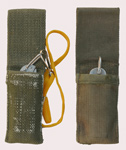 The issue form, for S.A.S. is described and illustrated in that section, but the usefulness was not lost on other soldiers. It is handier having an accessible knife, rather than one tucked in a pocket, under your webbing. It was easy enough to fabricate from suitable lengths of web strapping, or from load securing straps.
The issue form, for S.A.S. is described and illustrated in that section, but the usefulness was not lost on other soldiers. It is handier having an accessible knife, rather than one tucked in a pocket, under your webbing. It was easy enough to fabricate from suitable lengths of web strapping, or from load securing straps.
The illustration at left shows a user-made Sheath on the left and the issue version on the right. Note the finer weave of the latter, which was more “Patt. ‘44” type webbing, whereas the user-made Sheath is standard webbing, of a heavier weight. It could be used to carry the issue clasp knife, but quite probably a Trade Pattern knife, of the soldier’s own choice, could be substituted. Construction was simplicity itself, a length of 2-inch width webbing being folded upwards into a pocket and downwards on the reverse face, to form a belt loop. Where the S.A.S. version had the cut edge protected by a thin web binding, the user-made version has an internal hem at this point.
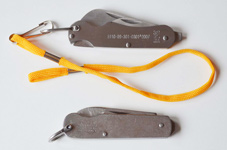 In the above photo of the Sheaths, that on the left contains F1 5110-99-301-0301, made in 2007, which is a lock-knife, with tin opener and screwdriver. Note the attenuated Broad Arrow. The right-hand contains a 1945 version, made by Wadl & Butcher of Sheffield. This is non-locking, as were all previous Clasp knives and here with just a blade, tin-opener and screwdriver extension. Another common type was the stainless steel F1 5110-99-975-7403 Knife, pocket, which had a blade, tin-opener, screwdriver and a marline spike, mythically for getting Boy Scouts out of horses’ hooves, but of rather more use to sailors in their ropework.
From the Carl Woods Collection. Photographs © Carl Woods, 2012.
In the above photo of the Sheaths, that on the left contains F1 5110-99-301-0301, made in 2007, which is a lock-knife, with tin opener and screwdriver. Note the attenuated Broad Arrow. The right-hand contains a 1945 version, made by Wadl & Butcher of Sheffield. This is non-locking, as were all previous Clasp knives and here with just a blade, tin-opener and screwdriver extension. Another common type was the stainless steel F1 5110-99-975-7403 Knife, pocket, which had a blade, tin-opener, screwdriver and a marline spike, mythically for getting Boy Scouts out of horses’ hooves, but of rather more use to sailors in their ropework.
From the Carl Woods Collection. Photographs © Carl Woods, 2012.
CC 1286 Knife, clasp, No. 4 - The code – note V.A.O.S. Section CC, not F1 Tools – was taken from a post-war Authorised Scale of Training Equipment for Signal Platoons, these being in the A.C.F., or C.C.F.. Anybody know which type this was?
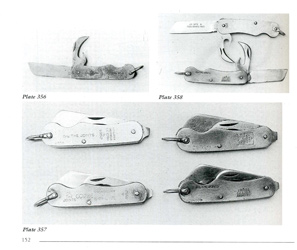 Yes, someone did! Dr. Richmond Dutton contacted us with a page from British and Commonwealth Military Knives, by Ron Flook (Pub. Airlife, 1999. ISBN 185310986X). Ron has very kindly given us permission to reproduce the relevant plate – and therefore the answer I required. CC 1286 was the two-piece knife and CC 1287 was the three-piece form, with a marline spike. Respectively, they became F1 7340-99-975-7402 and -7403. By 1958, Section CC of the C.C.N. was Underclothing, Necessaries and Related Articles, whereas Section F1 of the V.A.O.S. was Hand Tools (non-powered), so the Army had evidently re-classified the knives to a more logical catalogue section.
Yes, someone did! Dr. Richmond Dutton contacted us with a page from British and Commonwealth Military Knives, by Ron Flook (Pub. Airlife, 1999. ISBN 185310986X). Ron has very kindly given us permission to reproduce the relevant plate – and therefore the answer I required. CC 1286 was the two-piece knife and CC 1287 was the three-piece form, with a marline spike. Respectively, they became F1 7340-99-975-7402 and -7403. By 1958, Section CC of the C.C.N. was Underclothing, Necessaries and Related Articles, whereas Section F1 of the V.A.O.S. was Hand Tools (non-powered), so the Army had evidently re-classified the knives to a more logical catalogue section.
Rog Dennis 2012/13